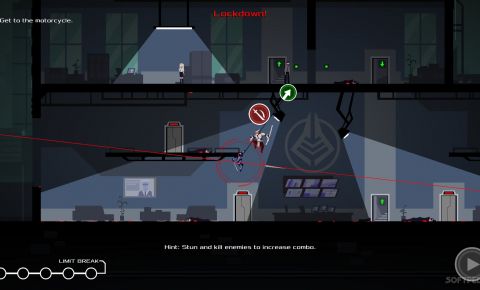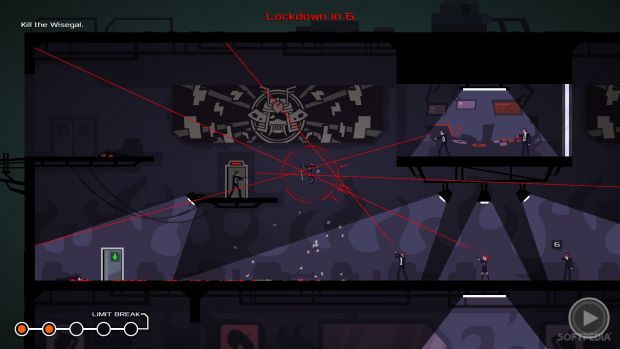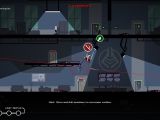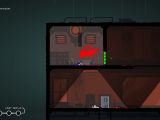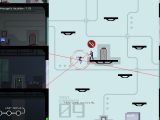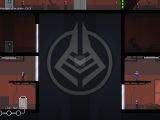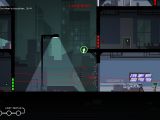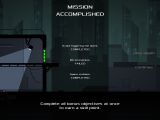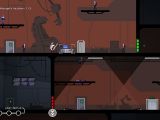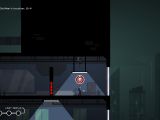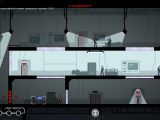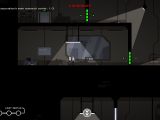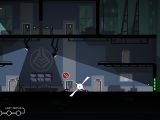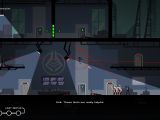Ronin is a stealth-based platformer with action elements, and at first sight, that combination sounds rather unable to deliver a playable game, let alone a complex take on stealth and combat which encourages players to think but also gives them plenty of moments to act on instinct and gamble with the life of the protagonist.
The title is created by Tomasz Waclawek and published by Devolver Digital, and it continues the company’s attempts to deliver experiences that offer a new take on some familiar mechanics while challenging the player.
Ronin is similar, in some respects, to the Gunpoint title from Tom Francis, and the two creators seem to be very happy to be drawing on the same core concepts, even if the final gameplay mechanics of their games are different in both tone and execution.
Story
Ronin is a game about revenge, spilled blood and the ability of one character to look incredibly cool while going through windows with a katana in her hand.
Clearly, the development team has worked more on the core mechanics of the title rather than on the story, but the minimalist take, with the black and white photograph that is marked by red as the levels are completed, is a great touch, revealing layers of detail as the game progresses.
I also love the hint system for Ronin and the fact that, once it delivers the necessary details about the controls and the moves gamers can perform, it shifts to a fourth wall breaking routine which addresses the similarities to Gunpoint. Also, I like the fact that at least one of the visual aids does not always deliver the best results.
Ronin is a video game that resembles a movie in many ways and almost encourages gamers to die as many times as needed in order to try and play each scene differently, aiming for the best possible result, which also tends to be the most heroic one.
There are three core objectives for each level in the game and only players who manage to reach all three at the same time will get a point that they can use to level up their character, something that will certainly encourage replaying.
Gameplay
Ronin starts off as a stealth experience, with the player given a list of objectives to achieve and pointed to their location, but it quickly becomes clear that the game wants the player to take out all the enemies in the level and, even better, do it all without triggering an alarm.
Time flows continuously as long as the enemies are unaware of the presence of the gamer-controlled ninja (although a mouse click pauses the action to determine where to jump) and the switch to turn-based takes place as soon as the red helmet intruder has been detected.
The protagonist is able to execute some impressive jumps and is also able to use a grapple to change her trajectory when she is in the air, as long as she can connect it to a solid surface nearby.
“Using these relatively limited tools and a sharp blade that can take out enemies at close range, players need to move around the levels, achieving objectives and taking out enemies, all without allowing them to raise the alarm.”
It sounds much easier than it actually is, and despite the very cool skills that gamers can use, Ronin is a tough game that requires either a mix of careful planning and solid execution or a solid chunk of luck and good on-the-fly plan development.
Enemies initially seem slow and unable to actually target the player character, but she is very fragile, and once teleporting enemy ninjas and automatic weapons are introduced, it gets much harder to navigate a level, especially when the space is too limited to escape using longer jumps.
Ronin might seem like a short adventure after the first boss is taken down, but the difficulty level ramps up relatively quickly and it takes quite a long time to get to the final opponent, especially for those who want to get access to all the skill points.
It takes time to get an instinct for how the various weapons work and whether a certain jump will get the ninja to safety or will leave her exposed at the worst moment.
Where a jump ends for one turn, especially when the player does not aim for a wall or other solid surface, is often more important than the final destination because it modifies the targeting for enemies and changes the way the battlespace is delimited.
The developer of Ronin has carefully calibrated each level to give gamers a challenge, and every time I was frustrated by my inability to clear an area, I was actually using the wrong approach.
A bit of thinking led to changes in tactics that delivered solid results when I calibrated my overall plan.
The hardest challenge the title offers is the lockdown that guards can activate, which is on an eight turn countdown and sometimes causes weird scenes as I am forced to chase and knock out the guards who are using their radios while dodging bullets from their comrades.
I initially got to the fourth boss in Ronin without acquiring even one skill point, which made the title exceedingly hard, and on my second playthrough, I focused on obtaining them, with thrown swords and stealth the most important of the tools that can be acquired.
Graphics and audio
Ronin is entirely 2D and the developer has carefully chosen the shape of the levels and the colors for both the environment and the characters to make it easy to judge the situation at a glance, with red always a clear indicative for danger and the cold reassurance of white showing where the player can move each turn.
The fact that players can use right click to scrolls around the entire level before they make a move is a great way to create plans, even though most of them will need to radically change once the ninja character is detected by an enemy and, even worse, lockdown takes place.
I also love the sparing use of blood and the curtailed yet acrobatic combat moves, which hint at the violence that the main character can visit on her enemies, but also at her professional approach to killing and survival.
The music in Ronin is suited to the frantic action and techno-thriller feel of the title most of the time, but I blame its pumping rhythm for some of my bad decisions during combat because I feel compelled to go for the big action moment rather than keep it simple in order to take out enemies one at a time.
The Good
- Turn-based action mechanics
- Level design and complexity
The Bad
- Some difficulty spikes
- Limited narrative details
Conclusion
There are a lot of moments when a particular room or challenge frustrated me, and I was unable to find a way to take out all the enemies without taking out civilians or sounding the alarm.
But even as I took a break from the title, those moments continued to play around in my head and I often found myself trying once more, looking for that improved jump, that last-minute sword throw, or that careful grapple swing that would lead me to the objective.
Ronin does not offer a multiplayer mode, but if the game gets expanded in the future, it would be great to meet other players and either work with them to clear rooms of enemies or simply battle them using the solid turn-based system.
 14 DAY TRIAL //
14 DAY TRIAL // 